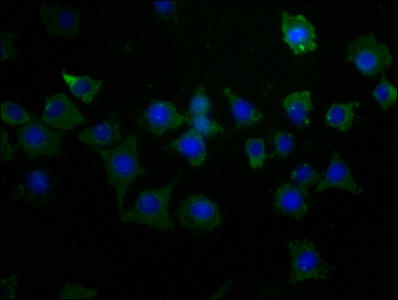Description
| Antibody Name: | KCNB1 Antibody (PACO63783) |
| Antibody SKU: | PACO63783 |
| Size: | 50ul |
| Host Species: | Rabbit |
| Tested Applications: | ELISA, IF |
| Recommended Dilutions: | ELISA:1:2000-1:10000, IF:1:50-1:200 |
| Species Reactivity: | Human |
| Immunogen: | Recombinant Human Potassium voltage-gated channel subfamily B member 1 protein (535-765AA) |
| Form: | Liquid |
| Storage Buffer: | Preservative: 0.03% Proclin 300 Constituents: 50% Glycerol, 0.01M PBS, pH 7.4 |
| Purification Method: | Antigen Affinity Purified |
| Clonality: | Polyclonal |
| Isotype: | IgG |
| Conjugate: | Non-conjugated |
 | Immunofluorescence staining of SH-SY5Y cells with PACO63783 at 1:50, counter-stained with DAPI. The cells were fixed in 4% formaldehyde, permeabilized using 0.2% Triton X-100 and blocked in 10% normal Goat Serum. The cells were then incubated with the antibody overnight at 4°C. The secondary antibody was Alexa Fluor 488-congugated AffiniPure Goat Anti-Rabbit IgG(H+L). |
| Background: | Voltage-gated potassium channel that mediates transmembrane potassium transport in excitable membranes, primarily in the brain, but also in the pancreas and cardiovascular system. Contributes to the regulation of the action potential (AP) repolarization, duration and frequency of repetitive AP firing in neurons, muscle cells and endocrine cells and plays a role in homeostatic attenuation of electrical excitability throughout the brain. Plays also a role in the regulation of exocytosis independently of its electrical function (By similarity). Forms tetrameric potassium-selective channels through which potassium ions pass in accordance with their electrochemical gradient. The channel alternates between opened and closed conformations in response to the voltage difference across the membrane. Homotetrameric channels mediate a delayed-rectifier voltage-dependent outward potassium current that display rapid activation and slow inactivation in response to membrane depolarization. Can form functional homotetrameric and heterotetrameric channels that contain variable proportions of KCNB2; channel properties depend on the type of α subunits that are part of the channel (By similarity). Can also form functional heterotetrameric channels with other α subunits that are non-conducting when expressed alone, such as KCNF1, KCNG1, KCNG3, KCNG4, KCNH1, KCNH2, KCNS1, KCNS2, KCNS3 and KCNV1, creating a functionally diverse range of channel complexes. Heterotetrameric channel activity formed with KCNS3 show increased current amplitude with the threshold for action potential activation shifted towards more negative values in hypoxic-treated pulmonary artery smooth muscle cells (By similarity). Channel properties are also modulated by cytoplasmic ancillary β subunits such as AMIGO1, KCNE1, KCNE2 and KCNE3, slowing activation and inactivation rate of the delayed rectifier potassium channels (By similarity). In vivo, membranes probably contain a mixture of heteromeric potassium channel complexes, making it difficult to assign currents observed in intact tissues to any particular potassium channel family member. Major contributor to the slowly inactivating delayed-rectifier voltage-gated potassium current in neurons of the central nervous system, sympathetic ganglion neurons, neuroendocrine cells, pancreatic β cells, cardiomyocytes and smooth muscle cells. Mediates the major part of the somatodendritic delayed-rectifier potassium current in hippocampal and cortical pyramidal neurons and sympathetic superior cervical ganglion (CGC) neurons that acts to slow down periods of firing, especially during high frequency stimulation. Plays a role in the induction of long-term potentiation (LTP) of neuron excitability in the CA3 layer of the hippocampus (By similarity). Contributes to the regulation of glucose-induced action potential amplitude and duration in pancreatic β cells, hence limiting calcium influx and insulin secretion. Plays a role in the regulation of resting membrane potential and contraction in hypoxia-treated pulmonary artery smooth muscle cells. May contribute to the regulation of the duration of both the action potential of cardiomyocytes and the heart ventricular repolarization QT interval. Contributes to the pronounced pro-apoptotic potassium current surge during neuronal apoptotic cell death in response to oxidative injury. May confer neuroprotection in response to hypoxia/ischemic insults by suppressing pyramidal neurons hyperexcitability in hippocampal and cortical regions (By similarity). Promotes trafficking of KCNG3, KCNH1 and KCNH2 to the cell surface membrane, presumably by forming heterotetrameric channels with these subunits. Plays a role in the calcium-dependent recruitment and release of fusion-competent vesicles from the soma of neurons, neuroendocrine and glucose-induced pancreatic β cells by binding key components of the fusion machinery in a pore-independent manner (By similarity). |
| Synonyms: | Potassium voltage-gated channel subfamily B member 1 (Delayed rectifier potassium channel 1) (DRK1) (h-DRK1) (Voltage-gated potassium channel subunit Kv2.1), KCNB1 |
| UniProt Protein Function: | Kv2.1: a potassium voltage-gated channel protein of subfamily B. Mediates the voltage-dependent potassium ion permeability of excitable membranes. Channels open or close in response to the voltage difference across the membrane, letting K ions pass in accordance with their electrochemical gradient.Protein type: Channel, potassium; Membrane protein, integral; Membrane protein, multi-pass; Channel, cation; Channel, ligand-gatedChromosomal Location of Human Ortholog: 20q13.2Cellular Component: postsynaptic membrane; voltage-gated potassium channel complex; dendrite; plasma membrane; integral to membraneMolecular Function: protein binding; outward rectifier potassium channel activity; delayed rectifier potassium channel activity; protein N-terminus bindingBiological Process: synaptic transmission; energy reserve metabolic process; regulation of insulin secretion; protein homooligomerizationDisease: Epileptic Encephalopathy, Early Infantile, 26 |
| UniProt Protein Details: | |
| NCBI Summary: | Voltage-gated potassium (Kv) channels represent the most complex class of voltage-gated ion channels from both functional and structural standpoints. Their diverse functions include regulating neurotransmitter release, heart rate, insulin secretion, neuronal excitability, epithelial electrolyte transport, smooth muscle contraction, and cell volume. Four sequence-related potassium channel genes - shaker, shaw, shab, and shal - have been identified in Drosophila, and each has been shown to have human homolog(s). This gene encodes a member of the potassium channel, voltage-gated, shab-related subfamily. This member is a delayed rectifier potassium channel and its activity is modulated by some other family members. [provided by RefSeq, Jul 2008] |
| UniProt Code: | Q14721 |
| NCBI GenInfo Identifier: | 24418854 |
| NCBI Gene ID: | 3745 |
| NCBI Accession: | Q14721.2 |
| UniProt Secondary Accession: | Q14721,Q14193 |
| UniProt Related Accession: | Q14721 |
| Molecular Weight: | 95,878 Da |
| NCBI Full Name: | Potassium voltage-gated channel subfamily B member 1 |
| NCBI Synonym Full Names: | potassium voltage-gated channel, Shab-related subfamily, member 1 |
| NCBI Official Symbol: | KCNB1 |
| NCBI Official Synonym Symbols: | DRK1; KV2.1; EIEE26; h-DRK1 |
| NCBI Protein Information: | potassium voltage-gated channel subfamily B member 1; h-DRK1 K(+) channel; potassium channel protein DRK1; delayed rectifier potassium channel 1; delayed rectifier potassium channel Kv2.1; voltage-gated potassium channel subunit Kv2.1 |
| UniProt Protein Name: | Potassium voltage-gated channel subfamily B member 1 |
| UniProt Synonym Protein Names: | Delayed rectifier potassium channel 1; DRK1; h-DRK1; Voltage-gated potassium channel subunit Kv2.1 |
| Protein Family: | Potassium voltage-gated channel subfamily |
| UniProt Gene Name: | KCNB1 |
| UniProt Entry Name: | KCNB1_HUMAN |
| Antibodies |
| Phospho-KCNB1 (S805) Antibody (PACO05959) |
| Phospho-KCNB1 (S567) Antibody (PACO05960) |
| KCNB1 Antibody (PACO05961) |
| KCNB1 Antibody (PACO05962) |
| Secondary Antibody |
| Anti-HRP Goat Anti-Rabbit IgG (H+L) Antibody (CABS014) |
| Recommended Products |
| Anti-FITC Goat Anti-Rabbit IgG (H+L) Antibody (CABS011) |
| Anti-HRP-conjugated Beta Actin Antibody (CABC028) |






